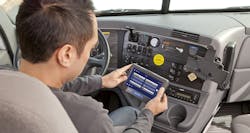Tom Cuthbertson, vice president of regulatory compliance at Omnitracs, explained in a webinar this week that “significant technical requirements” and “quite a few security items” will need to be addressed to ensure the self-certification process for electronic logging devices (ELDs) is successful.
That includes making sure the ELD selected by a fleet or owner-operator meets diagnostic and malfunction reporting rules, which can be quite stringent, along with data encryption guidelines for when ELD information is transferred to enforcement officers during roadside inspections.
“Your ELD must meet the enforcement and data transfer requirements and [ELD] data must be encrypted properly or servers won’t accept the information,” he explained.
Cuthbertson added that if the data transfer fails to work during roadside inspections, an ELD’s display screen will remain a valid way to audit the driver’s logbook data. “That’s important to keep in mind,” he stressed.
Another key point Cuthbertson made is that the diagnostic and malfunction rules for ELDs are fairly rigid and don’t leave much time to correct issues.
For example if there is a power compliance or engine synchronization diagnostic issue that occurs for 30 minutes in a 24 hour period, it becomes a “malfunction,” which must be fixed within an eight-day period.
In some cases, variances in GPS data can cause ELDs to slip into malfunction mode, he added.
Cuthbertson noted, too, that the ELD testing guidelines offered by the Federal Motor Carrier Safety Administration (FMCSA) run to 454 pages, which can significantly lengthen the time needed to ensure the devices are properly certified.
Yet he pointed out that ELDs do not need to be technically “certified” until Dec. 18 of 2017 so fleets adopting them now have a time window in which adjustments can be made.
Another way to buy more time is for a fleet or owner-operator to adopt automatic onboard recording devices or “AOBRDs” ahead of the 2017 ELD adoption deadline.
“If you install an AOBRD prior to Dec. 18 of 2017 you come into the grandfather clause – you get an additional two years beyond initial [ELD] compliance date,” Cuthbertson said.This might be a wise choice for some fleets as he indicated ELD parameters remain in a “messy state” right now.
For example, ELDs begin recording against a driver’s “drive time” hours when vehicle motion is detected at 5 mph or above. But if you stop driving for 5 minutes, then the device must ask a question: does the driver want to stay in “drive” or does the ELD “clock” switch over to on-duty time? The device will then wait for a minute before automatically switching into “on duty” status if there is no interaction by the driver.
“The driver has to interact with ELD and has to make decision on [his or her] duty status,” Cuthbertson explained.
Despite all of those complexities, however, his experience indicates most drivers who have never used ELDs before adapt relatively quickly.
“In terms of the learning curve, about 20% of drivers in my experience pick it up [using ELDs] in a few days or a week,” Cuthbertson noted. “Now, some people just have trouble of technology so may take several weeks to learn how to use them – and may need retraining along the way. But usually, in my experience, within 30 to 60 days everyone gets up to speed.”
A few other critical points Cuthbertson made about ELDs during his presentation included:
- Make sure driver log in/long off and commercial vehicle power on/power data is being captured by the ELD.
- The driver must certify the ELD data at the beginning and end of the day and any edits made by in the “back office” must be reviewed by the driver and certified.
- Watch how you set up unassigned vehicle moves, such as technicians taking vehicles out for road tests. If no one logs in, the “movement” goes to the driver assigned to vehicle – and if there are too many unreconciled “moves” this create a problem during DOT audits.
- The ELD rule very specifically says that if the vehicle identification number (VIN) date code is 2000 or newer, you are required to have an ELD. If the VIN date is older than 2000, you are not required to have an ELD, but that does not alleviate the fact that the driver must keep a paper logbook.
- It is the VIN number on the truck that matters, NOT the age of the engine. That means fleets using glider kits that are model year 2000 or newer must use ELDs.
- One important caveat for “short haul” drivers operating within a 100 mile radius of their home base: If they break the 100 mile limit more than eight times in 30 day period, they will need to use an ELD for 30 days. However, that determination is made driver by driver; an entire short haul fleet is not affected if just one of its drivers is tagged to use an ELD.
About the Author
Sean Kilcarr
Editor in Chief
Sean Kilcarr is a former longtime FleetOwner senior editor who wrote for the publication from 2000 to 2018. He served as editor-in-chief from 2017 to 2018.


